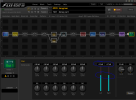meshugganner
New Member
Hi all,
This is my first post here! Been lurking the forums quite a bit over the last couple weeks, nice to finally meet y'all. Got the AFX III recently, and am also extremely new to recording, after having played guitar most of my life. I've been overwhelmed with all this (learning DAW/AFX/plugins/everything) the past couple months, but some pieces of the whole process are starting to come together.
Anyway - I have searched through the web & this forum for answers to my question, and while I think I found some good info, I'm a little confused as to what I'd actually do as a result.
Here's my basic setup:
Guitar >>> AFXIII >>> SPDIF out into Focusrite Clarett+ 4pre >>> PC (Cubase 12pro)
***I also have the USB out going into the PC for Axe Edit.
The issue is this:
I have my individual scene/preset level in the AFX leveled for recording so that if I'm looking at the "Out 1" block VU meters in Axe Edit, nothing ever (or very rarely) hits the red (> 0 dB). From what I understand, this is what you want, since it's a digital connection, the 'ceiling' is 0dB. So basically I'm under the impression that I have 'maximized' the AFX levels as much as I can.
However - when I look at the VU meter in Cubase, the level is nowhere near 0dB. It doesn't sound bad, or have any artifacts or anything. I'm just trying to understand why this signal that is supposedly at the 0bD ceiling in the AFX, is nowhere near 0 in the DAW. Reading some other posts, I get the sense that maybe "0dB" is a relative concept, so 0bD in the AFX, may not necessarily translate to 0dB in the DAW. Or something, I dunno.
SO, assuming this is all true, and the even though my signal in Cubase is kinda low, it's still sufficient for recording/processing/mixing purposes - what's the best way to compensate for this?
Do I literally just turn the fader for that track in Cubase up over 0dB?
I know that with subsequent track/parallel/guitarbus/stereobus processing, the volume of that guitar track can be increased with like limiters/compressors & all that, but for starting out, is it advised to just start by turning the fader for the individual track up above 0 before doing any of that?
Or would I leave that fader at 0, and let a limiter or something handle the flat level increase?
Alternatively - have I misunderstood literally everything I've been reading (definitely possible), and should the signal in Cubase appear just as strong as in the AFX?
Thanks to anyone who has any knowledge/experience with this!!!
Here's a link to something I've been working on - really the first thing I've ever written by myself beyond a riff or two. Feel free to critique!:
This is my first post here! Been lurking the forums quite a bit over the last couple weeks, nice to finally meet y'all. Got the AFX III recently, and am also extremely new to recording, after having played guitar most of my life. I've been overwhelmed with all this (learning DAW/AFX/plugins/everything) the past couple months, but some pieces of the whole process are starting to come together.
Anyway - I have searched through the web & this forum for answers to my question, and while I think I found some good info, I'm a little confused as to what I'd actually do as a result.
Here's my basic setup:
Guitar >>> AFXIII >>> SPDIF out into Focusrite Clarett+ 4pre >>> PC (Cubase 12pro)
***I also have the USB out going into the PC for Axe Edit.
The issue is this:
I have my individual scene/preset level in the AFX leveled for recording so that if I'm looking at the "Out 1" block VU meters in Axe Edit, nothing ever (or very rarely) hits the red (> 0 dB). From what I understand, this is what you want, since it's a digital connection, the 'ceiling' is 0dB. So basically I'm under the impression that I have 'maximized' the AFX levels as much as I can.
However - when I look at the VU meter in Cubase, the level is nowhere near 0dB. It doesn't sound bad, or have any artifacts or anything. I'm just trying to understand why this signal that is supposedly at the 0bD ceiling in the AFX, is nowhere near 0 in the DAW. Reading some other posts, I get the sense that maybe "0dB" is a relative concept, so 0bD in the AFX, may not necessarily translate to 0dB in the DAW. Or something, I dunno.
SO, assuming this is all true, and the even though my signal in Cubase is kinda low, it's still sufficient for recording/processing/mixing purposes - what's the best way to compensate for this?
Do I literally just turn the fader for that track in Cubase up over 0dB?
I know that with subsequent track/parallel/guitarbus/stereobus processing, the volume of that guitar track can be increased with like limiters/compressors & all that, but for starting out, is it advised to just start by turning the fader for the individual track up above 0 before doing any of that?
Or would I leave that fader at 0, and let a limiter or something handle the flat level increase?
Alternatively - have I misunderstood literally everything I've been reading (definitely possible), and should the signal in Cubase appear just as strong as in the AFX?
Thanks to anyone who has any knowledge/experience with this!!!
Here's a link to something I've been working on - really the first thing I've ever written by myself beyond a riff or two. Feel free to critique!:

